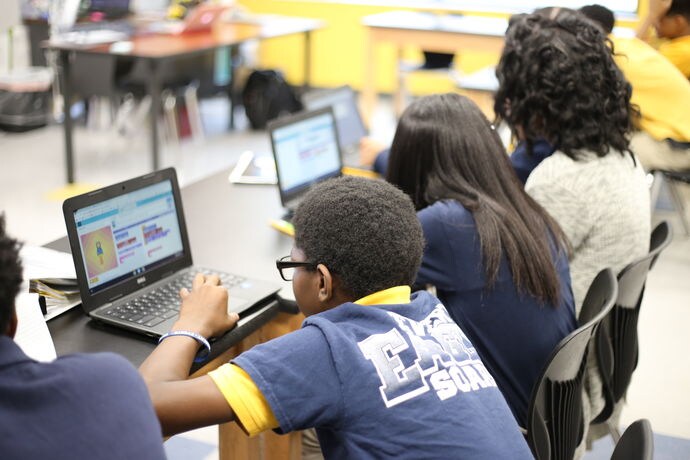Programmed for Success: 600+ Hours of Code Across Corps Member and Alumni Classrooms

December 12, 2018
Projected to grow approximately 13% in the next 10 years, computer and information technology jobs are quickly becoming one of the highest in-demand jobs in the country—and last week, 30 corps member and alumni classrooms across Indianapolis ensured student access to this high-growth career field by participating in Hour of Code week, December 3-7.
An annual global initiative to introduce millions of students to computer science, Hour of Code is implemented in more than 180 countries and provides activities like using HTML and JavaScript to design games and stories. In the U.S., research shows that women and people of color are significantly underrepresented in the tech workforce. Among computing and related mathematics jobs in the U.S., only 26% are held by women, while only 7.9% and 6.8% are held by Black and Hispanic employees, respectively. Fortunately, with numerous computer science education initiatives like Hour of Code, access is expanding with strong, positive student response.
“Literally one the top three best days I’ve ever had teaching,” said corps member Brea Porter, who led Hour of Code programming in her first grade classroom at James Whitcomb Riley School 43. “I loved it, the kids loved it, and I can’t wait to do it again!”
Additionally, local tech volunteers in a spectrum of roles across software engineering, digital marketing and design, quality assurance, and business technology joined in to share about their careers and help support students as they learned to code. They represent companies like Finish Line, Lessonly, Salesforce, Studio Science, Genesys, and Blue Horseshoe Solutions.
“I didn't have this opportunity back in high school,” said Bunmi Akintomide, systems specialist at Salesforce and also the membership and community liaison lead for BOLDforce, Salesforce’s Black Organization for Leadership and Development. “I know how much this would've changed a lot for me if I had this exposure to technology…As a person of color, being able to stand in front of the students, will also encourage other students of color and give them hope in pursuing career in technology.”
Corps member and T.C. Howe Community High School teacher Sarah Medve, who implemented Hour of Code in her eighth grade math classrooms, shared about her students’ enthusiasm to meet with tech volunteers: “I even had some students tell me they had ‘practiced last night’ so that they could code well for our visitors today.” Medve was a former tech employee herself prior to joining the corps, working as a Technical Recruiter for Celertek.
“It is such a powerful moment each year when so many different sectors come together to provide this access point to computer science and tech-related fields.”
This is the second year that TFA has organized Hour of Code programming for corps member and alumni classrooms. Interest grew significantly from last year, with double the number of attendees at a free training facilitated by Nextech, and more than 600 total students participating, compared to around 370 last year, across elementary through high school classrooms led by corps members and alumni teachers. Popular coding activities this year include Dance Party, Minecraft, and Flappy Bird.

“It is such a powerful moment each year when so many different sectors come together to provide this access point to computer science and tech-related fields,” said Kate Brierty, director of corps member learning at TFA Indy. “For some students, this is just a fun annual event they look forward to, but many more students take this as an entry point to start clubs, research related education and career opportunities, or start coding with their families. Students are brilliant, and they make some incredible things happen when they are given the opportunity.”


